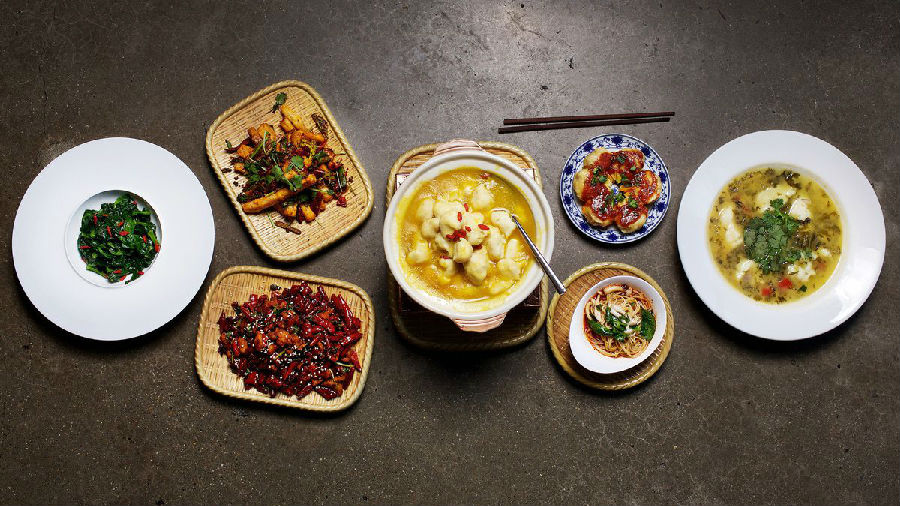來源于《圖書與藝術(shù)》版塊
Immigration on a plate
盤子上的移民
A bao in every steamer
每個蒸籠上都有一個包子
The development of Chinese-American cuisine reflects the community’s own upward trajectory
美籍華人烹飪的發(fā)展反映了社區(qū)自身的上升軌跡
For several years, beginning in the mid-2000s, devotees of Chinese food on America’s east coast obsessed over a mystery: Where was Peter Chang? A prodigiously talented—and peripatetic—chef, Mr Chang bounced around eateries in the south-east. One day diners at a strip-mall restaurant in suburban Richmond or Atlanta might be eating standard egg rolls and orange chicken; the next, their table would be graced by exquisite pieces of aubergine the size of an index finger, greaselessly fried and dusted with cumin, dried chillies and Sichuan peppercorns. Or by a soup made of pickled mustard greens and fresh sea bass, in its way as hauntingly perfect and austere as a Bach cello suite. A few months later, Mr Chang would move on.
從21世紀(jì)中期開始,連續(xù)數(shù)年,美國東海岸的中餐愛好者們正為一個謎而著迷:張鵬亮在哪里?作為一名天賦異稟、四處奔波的廚師,張鵬亮在美國東南部的餐館里奔波。某天在里士滿郊區(qū)或亞特蘭大的一家購物中心餐廳用餐的顧客,可能會吃到標(biāo)準(zhǔn)的蛋卷和橙汁雞;接下來,他們的餐桌上將會出現(xiàn)食指大小的精致茄子,無油煎炸,撒上孜然、干辣椒和花椒。或者用酸菜和新鮮海鱸魚做成的湯,就像巴赫的大提琴組曲一樣完美而又簡樸,令人回味無窮。幾個月后,張鵬亮就會離開。
He now seems to have settled down, running a string of restaurants bearing his name between Rockville, Maryland, and Virginia Beach. His latest—Q by Peter Chang—in the smart Washington suburb of Bethesda, may be his finest. The space is vast and quasi-industrial, with brushed concrete floors, massive pillars and not a winking dragon in sight. Order a scallion pancake, and what appears is not the typical greasy disc but an airy, volleyball-sized dough sphere. Jade shrimp with crispy rice comes under what looks like an upturned wooden bowl (perhaps, you think, for the shells). On inspection the bowl turns out to be the rice. Thumping through it with a spoon reveals perfectly cooked shrimp floating in shamrock-green sauce.
現(xiàn)在他似乎已經(jīng)安定下來了,在馬里蘭州羅克維爾和弗吉尼亞海灘之間經(jīng)營著一系列以他的名字命名的餐館。他最新的餐館Q by Peter Chang位于漂亮的華盛頓郊區(qū)貝塞斯達(dá),可能是他餐館中最高檔的。餐館空間很大,有點工業(yè)化的感覺,有刷過的混凝土地板,巨大的柱子,沒有一條眨眼的龍。點一份蔥油泡餅,你看到的不是那種典型的油膩的餅盤,而是一個通風(fēng)的、排球大小的面團(tuán)球。蝦仁鍋巴,下面是一個翻過來的木碗(也許,你認(rèn)為,是用來裝殼的)。細(xì)看,這碗原來是米飯做的。用勺子敲一下,你會發(fā)現(xiàn)煮熟的蝦浮在三葉草綠醬里。

A tab for two at Q can easily top three figures—several times the outlay on an average Chinese meal. Nor is Mr Chang’s the only such restaurant in the area: like many big American cities, Washington has seen a rise in high-end Chinese cuisine. That is good news, and not just for well-heeled gourmands who can tell shuijiao from shuizhu. The culinary trend is underpinned by two benign social ones. Chinese-Americans are becoming wealthier and more self-confident; and customers are shedding old stereotypes about Chinese food. To put it another way: sometimes a dumpling is more than just a dumpling.
在Q by Peter Chang餐廳,兩個人的價格很容易超過三位數(shù)——是普通中餐價格的好幾倍。張鵬亮的餐廳也不是該地區(qū)唯一一家這樣的餐廳:和許多美國大城市一樣,華盛頓也見證了高端中餐的崛起。這是個好消息,而且是個不僅僅針對可以區(qū)分水餃和水煮的富有美食家的好消息。兩種良性的社會趨勢支撐著這一烹飪趨勢。美籍華人正變得更加富有和自信;消費(fèi)者們正在擺脫對中國食物的陳舊成見。換句話說:有時候餃子不僅僅是一個餃子。
譯文由可可原創(chuàng),僅供學(xué)習(xí)交流使用,未經(jīng)許可請勿轉(zhuǎn)載。












